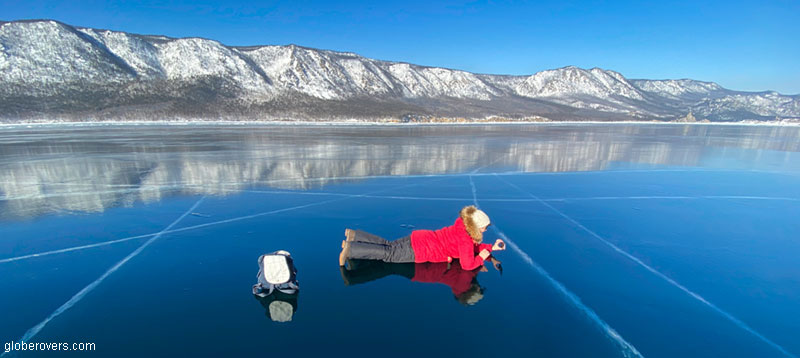
Glorious Sea, Sacred Baikal, is the name of a well-known Siberian folk song based on a poem dating back to the mid-1850s. With lyrics by the Russian poet, Dmitriy Davidov, it is believed that the music was composed by prisoners of Russia’s Nerchinsk gold-mines.
The song praises the cool winds blowing from the northern Barguzin Mountain Range; the beauty of the cold, clear waters of Siberia’s Lake Baikal; and the tasty endemic omul fish that have been living in these icy waters for millions of years.
Lake Baikal, the pearl of southern Siberia, is surrounded by mountains, forests and rivers with an immense and diverse natural beauty. The winter scenery is truly spectacular!
Siberia, known in Russia as “the land of mystery and silence”, is nearly incomprehensible in size. It brims with natural resources, diverse ecologies, unmatched natural beauty, and is home to several ethnic groups with colourful cultures.

In the southern part of Siberia, near the border with Mongolia, lies Lake Baikal. Baikal is the world’s deepest freshwater lake and also the largest lake by volume—holding roughly 20% of the planet’s freshwater supply.
Defying its massive volume of water, Lake Baikal freezes over during the bitterly cold Siberian winters when the lake’s surface is covered with a thick layer of ice. Towards the end of winter many roads criss-cross the frozen lake, connecting its islands to the lakeshore.
No time to read?
Scroll down to see the frozen bubbles…
While any time of the year is a great time to enjoy the activities and scenery around Lake Baikal, winter is unquestionably the most magical time. From around mid-December to late-March, the winter wonderland created on and around the lake is spectacular, and that is a massive understatement!
Lake Baikal is considered by many locals to be their ‘sacred Siberian sea with crystal clear water’. In 1996, it was declared a UNESCO World Heritage Site
Even though most visitors, locals and foreigners alike, come to see Lake Baikal, the wider area offers many incredible landscapes, snow-capped mountains, dense forests, endemic wildlife, traditional architecture, colourful festivals, exquisite cuisines, mineral hot springs, and even a city full of attractions.
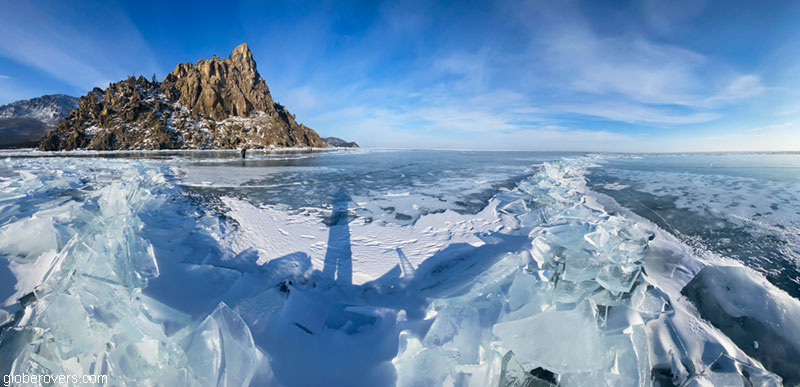
We start our winter journey in the regional capital, Irkutsk, to explore the architecture, its many orthodox churches and cathedrals, museums, art galleries, parks, markets, restaurants, and of course the wide variety of Russian vodkas.
From Irkutsk, we travel northeast along Lake Baikal to spend a few days exploring Olkhon, the largest of Baikal’s islands. While Olkhon offers countless opportunities to be mesmerized by the beauty created by its frozen waters, it is also a great place to experience the culture and food of the local Buryat people.
We then head south to the town of Listvyanka at the mouth of the Angara River along the southwestern tip of Lake Baikal. Here we board a hovercraft on the frozen lake and slowly sweep northeast along the upper lakeshore to the impressive Peschanaya Bay to be enthralled by the winter wonderland and clear ice on the lake.
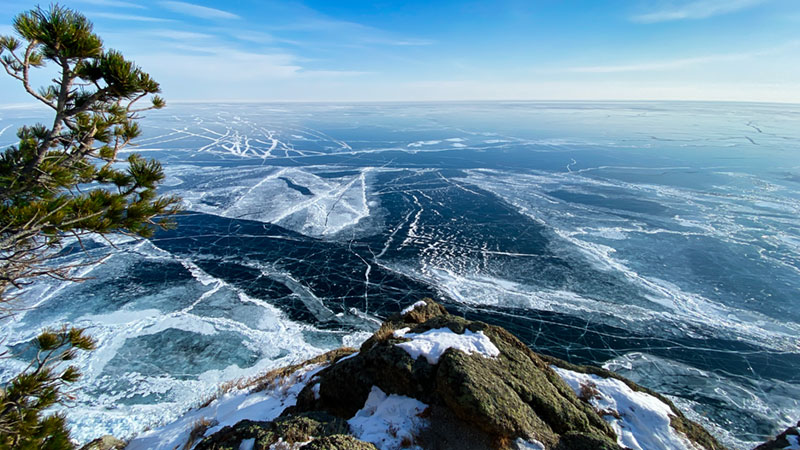
At the mouth of the Angara River lies Port Baikal, which is where train-lovers disembark the historic Circum-Baikal Railway train after a scenic ride along the lakeshore all the way from Slyudyanka at the southwestern tip of the lake. This area, as well as other areas along the lake, has several hiking trails which offer ample opportunities to enjoy the forests and lakeshore.
There is no better way to end a Siberian winter odyssey than by soaking in the thermal springs near Arshan village, nestled in the scenic Tunka Valley at the foot of the snow-covered Sayan Mountain Range.
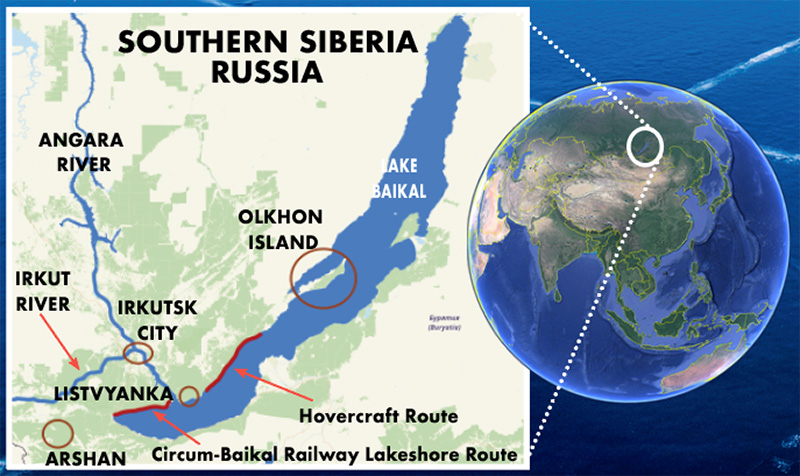
Why Travel to Lake Baikal in Siberia?
- The Low-Down:
Lake Baikal is one of the most intriguing lakes on planet earth. Not only is it the deepest lake, but it contains 20% of the planet’s freshwater… and a lot more record breaking features. Best of all, in winter it transforms into one of the most amazing winter-wonderworlds I have ever experienced! - The Brightest Highlight:
Everything to do with ice – Baikal is totally incredible! The very best of the area is the frozen water without snow so you can walk on the smooth crystal clear ice which can be up to 1.5 metres (5 ft) thick. - Intrepid Destination:
Other than a recent influx of Mainland China tourists, Lake Baikal is mostly visited by Russians, and being so large, much of the area is devoid of humans! - GlobeRovers Score (10 is highest):
Lake Baikal in winter is an experience you will never forget. I can’t give it less than 9.8 out of 10.
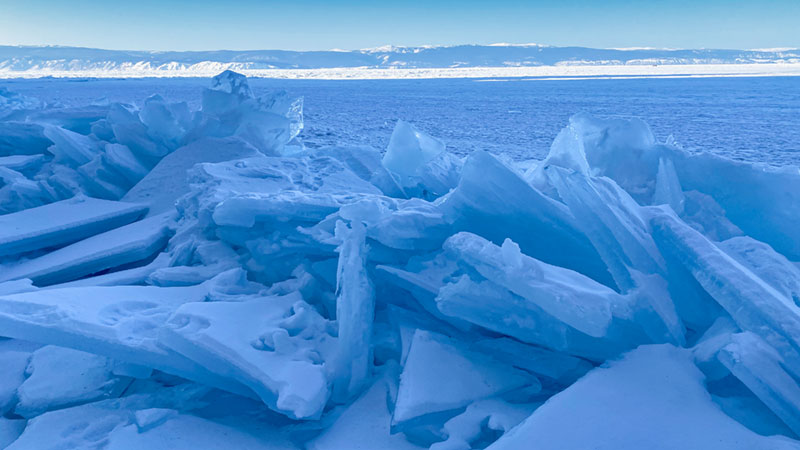
Table of Contents
Lake Baikal’s Unfathomable Features
Set deep within Russia’s Eastern Siberia near the Mongolian border, Lake Baikal is a superstar of superlatives in hydrology, geology, ecology and even in history. It is the deepest, oldest, and the most voluminous of all lakes on earth.
The lake first appeared about 25 million years ago in a vast rift valley created by the divergence of the planet’s tectonic plates. Even in our modern times this rift valley experiences around 2,000 earthquake tremors annually which constantly increases the size of the lake as the shores drift farther apart by about 2 centimetres (0.78 in) each year.
Lake Baikal is one of the most intriguing lakes on planet earth
It has been said that no lake is more “lake” than Lake Baikal. This is a true assessment when looking at a few of the lake’s mind-boggling facts.
Lake Baikal is the deepest freshwater lake in the world and is also the largest lake by volume—holding over 23,000 cubic kilometres (5,517 cubic miles) of water.
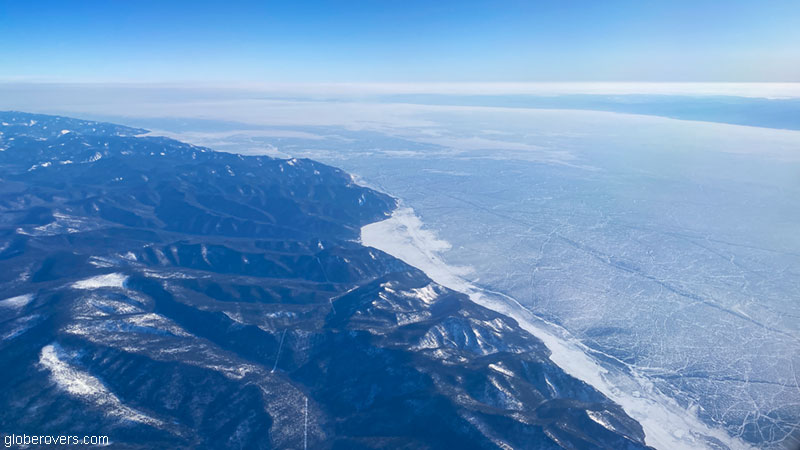
The lake’s maximum depth is 1,632 metres (5,354 ft) which lies 1,219 metres (4,000 ft) below sea level. It has an average depth of 744 metres (2,442 ft) and its whopping 31,722 square kilometre (12,248 sq mi) surface area is 455 metres (1,494 ft) above sea level. The surface area of Lake Baikal is exceeded only by that of three of the five North American Great Lakes (Superior, Huron, and Michigan).
While the lake’s maximum width is only 79.5 kilometres (49 mi), the crescent moon-shaped lake stretches for 640 kilometres (397 mi) in a northeastern direction from the town of Slyudyanka which is located 108 kilometres (67 mi) southwest of Irkutsk. The total coastline of the lake measures 2,100 kilometres (1,305 mi).
Over 300 streams and rivers flow into Lake Baikal, but the only outlet is the Angara River which flows north into the Yenisei River and eventually into the Arctic Ocean
With this impressive size, it is not surprising that Lake Baikal contains some 20 percent of all the freshwater in the earth’s lakes and rivers, making it larger in volume than the entire Amazon basin.
Baikal’s total volume of water is approximately equivalent to all five of the North American Great Lakes combined. So huge is Baikal that it reputedly takes an average of 330 years for a single water molecule to flow through it from an inlet in the far north to its only outlet (the Angara River) in the far south. The Selenga River flowing north from Mongolia contributes nearly 50 percent of the lake’s water.
This is an immense volume of water to be found in a single lake!
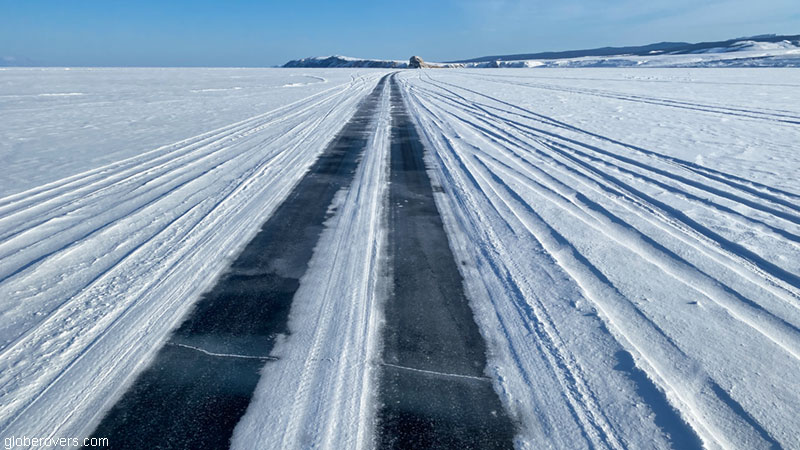
Wintertime around Lake Baikal is frigid and the water is icebound, even though the area is generally warmer than the rest of Siberia because the large body of water has a moderating force. Even so, the average winter air temperature is minus 21 degrees Celsius (-6°F) and during the Siberian cold snaps the temperature can drop as low as minus 40 degrees Celsius (-40°F) producing a layer of surface ice as thick as 1.5 metres (5 ft). The lake is normally frozen over by early January until May.
As Lake Baikal is considered one of the clearest lakes in the world, the ice here is like crystal. The area is quite dry in winter, so in the absence of snow, the smooth frozen water looks surreal. This makes mid-winter the most magical time to see how the freezing waters have created the most incredible winter scenery on the lake and along the lakeshore.

During spring and early summer when the lake contains a large amount of melted snow from the surrounding mountains, it is possible to see more than 40 metres (131 ft) down.
According to scientists, this unrivalled clarity is due to the melted snow’s purity, a lack of mineral salts in the lake, as well as the work done by Epischura baicalensis. These little fellows look like miniature crayfish, measuring 1.5 to 2 millimetres (0.06–0.08 in) in length, and feed on microscopic organic debris that would otherwise discolour the water and reduce visibility.
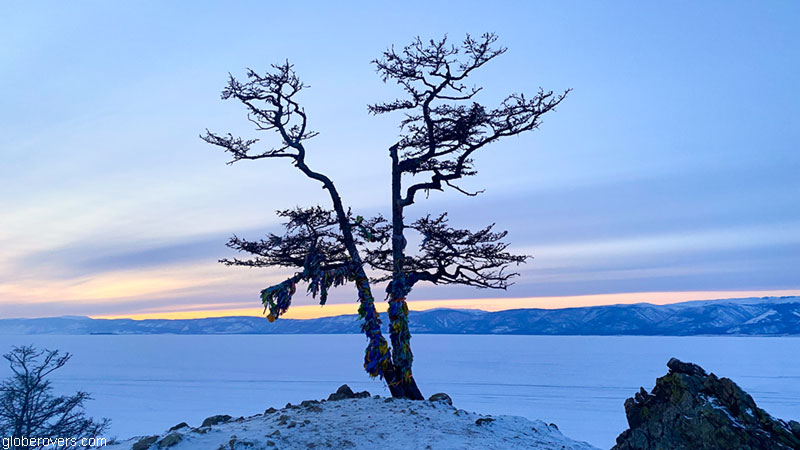

Fauna And Flora of Baikal
Lake Baikal is home to approximately 1,700 to 1,800 plant and animal species, of which about 80 percent are endemic, meaning they live nowhere else on the planet. The area is often referred to as the “Galapagos of Russia” because of its biodiversity and importance to evolutionary science.
The region is rich in fauna and flora and home to the Baikal seal
Among its endemic species of animals are the nerpa, also known as the Baikal seal (Phoca sibirica), the only exclusively freshwater seal in the world. Like the Caspian seal, it is related to the Arctic ringed seal. Scientists therefore suspect the Baikal seals may have swum down a prehistoric river from the Arctic.
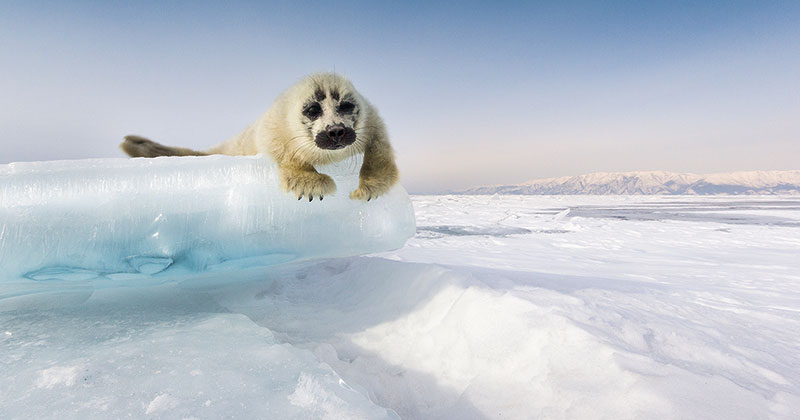
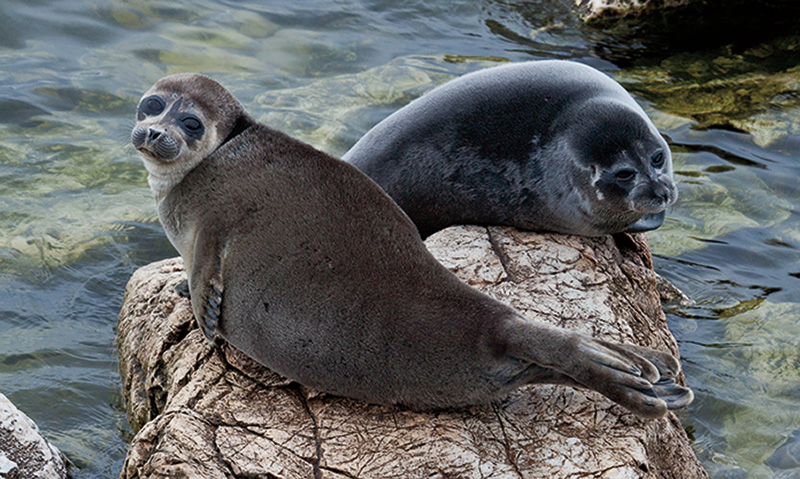
It is estimated that there are about 100,000 Baikal seals living a comfortable existence, mostly in the north of the lake, without any natural predators. These well-adapted seals have stumped evolutionary biologists who can’t figure out exactly how they came to live in freshwater some 1,700 kilometres (1,060 mi) from the nearest ocean, China’s Yellow Sea. The only threat to their peaceful existence has been man who has long hunted them for their prized pelts and fatty meat.
Scientists believe that the omul first appeared in Lake Baikal during the Ice Age
The area is also home to brown bears, deer, elk, polecats, ermine (short-tailed weasel), sable, and wolves that dwell around the shores of the lake, as do a large variety of birds, rodents and smaller creatures.
More than 50 species of fish live in the lake, belonging to seven main families. The most numerous of these are the 25 species of gobies. The lake’s most famous fish is the omul, as well as the grayling, and sturgeon. Also unique to the lake is the oily, scaleless, golomyanka which gives birth to live young.
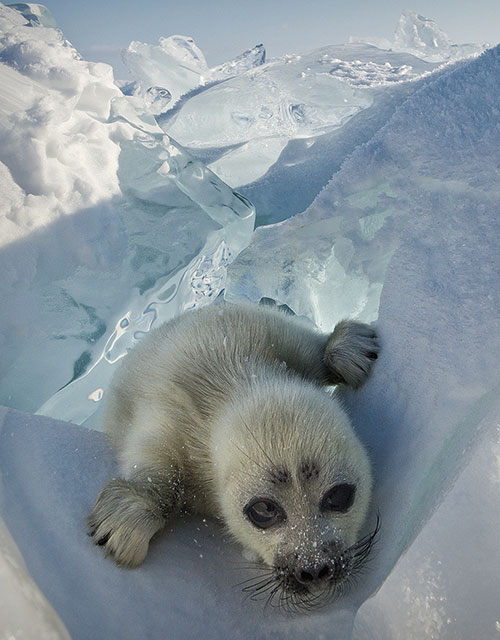
Omul (Coregonus migratorius) have long been the symbol of Lake Baikal, in addition to bread and vodka. The omul is a type of whitefish species in the salmon family that nowadays mainly live in Lake Baikal although in the distant past they were also found in high numbers in other rivers and lakes of the Ural mountain range which runs approximately north to south through western Russia.
There are five types of omul that differ morphologically and by their spawning areas—the five tributaries of Baikal. Their eggs are deposited on the sandy and pebbly lake floor with moderate water-flows. The development of its larvae lasts six to seven months. While a large number of the eggs will perish—either being buried deep under the silt or gobbled up by predators, those eggs that are lucky enough to hatch may live for 18 to 20 years.

It is well known that omul meat is very tasty and rich in vitamin B, zinc, and many other minerals. The fish is either eaten freshly baked, fried, cooked, preserved by salting or frozen, although smoked omul is the most popular.
Once a year, Siberians gather in the lake-shore town of Listvyanka to celebrate the Omul Festival which is a gastronomic feast during which restaurants compete in preparing the best omul dishes such as the famous sagudai dish (raw salted fish) which is enjoyed with ample servings of vodka.
In October 2017, after years of overfishing, the Russian government imposed an extendable three-year moratorium on catching the omul. These restrictions on omul fishing are still in place today but exclude the indigenous communities living in the lake region of Buryatia. These people are allowed to catch omul only for personal use, and restrictions apply to the size of catch, season of the year, and fishing equipment. However, there are loopholes in the regulations and many people are openly defying the rules.

While it is difficult to find omul in supermarkets in Irkutsk, watch out for plenty of small fish-stands in the villages near the lake. Here you will find on sale many fish species including the omul and the golomyanka. However, let the buyer beware.
The omul has a cousin called the peled (Coregonus peled), also called the northern whitefish. It has an almost identical body to that of the omul except that the nose is much smaller. When comparing the omul with the peled, the latter’s small upwards protruding nose easily distinguishes it from the omul.
While the meat of the two species tastes quite similar to the untrained taste buds, the higher fat content of the peled is quite profound. Therefore, among the locals the peled is not highly esteemed for cooking as the flesh is rather soft and considered by them as tasteless. When buying omul, be extra scrupulous to avoid being duped into believing the peled is omul.
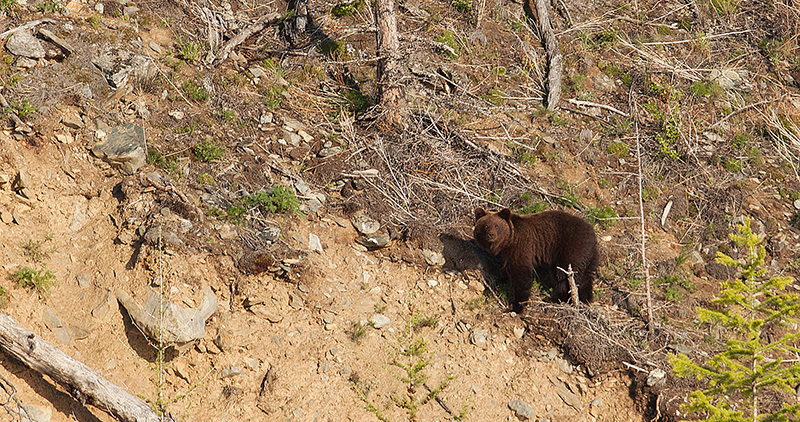
Another interesting fish from the lake is the golomyanka, better known as the “fatty fish”, which demands an acquired taste to eat it. Endemic to Lake Baikal, the golomyanka contains a whopping 30% of oil but is rich in vitamins. They live down in the depths of the lake at over 200 metres (656 ft) below the surface, where the water is always cold (about 5°C / 41°F) and highly pressured.
The golomyanka literally melts in the sun which, according to locals, leaves behind nothing but a few bones and a large oil spot. It is one of the most abundant fish in the lake and is the staple diet of the nerpa (Baikal seal).
The golomyanka is viviparous—giving birth to live young which have developed inside the body of the female. During autumn each female produces between 2,000 – 3,000 ready-to-swim larvae after which she dies.

Environmental Threats to the Lake
The surrounding wilderness of forests, plains and mountains that makes up the grand landscape of Siberia has been well-preserved over the centuries, except for some excessive logging. Some trees around Lake Baikal are over 800 years old.
During the last decade, an increasing amount of development has sprung up along the shores of the lake with the construction of several urban and resort communities. More recently, a spike in tourism (about 500,000 visitors a year, many from China), has drastically changed the lifestyle of the local communities along the lake shores who generally do not have adequate waste management systems to deal with the large number of tourists.
The pristine clear water of Lake Baikal is constantly under threat from pollution
Perhaps the most devastating development has been a paper mill that has discharged pollutants into the lake since 1966 which has resulted in a 31 square kilometre (12 sq mi) environmentally dead zone in the lake’s shallows.
Community-led opposition and environmental protection groups eventually forced its closure in 2008 on the grounds of ecological protection. Sadly, according to some reports, the mill reopened two years later under the pretence of using cleaner and safer practices.
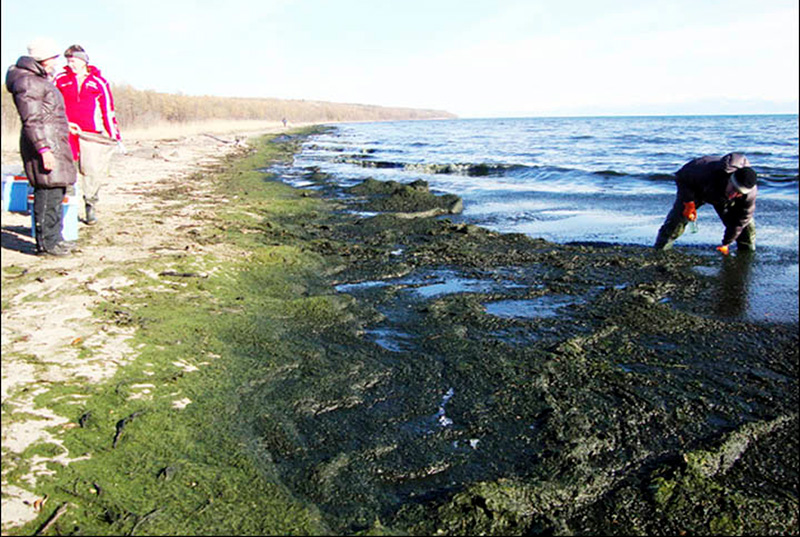
The lake now faces a massive problem with green algae blooms and the government’s failure to adequately respond to this threat. Many of the algae are toxic to other species and emit a terrible stench.
The algae are detrimental to water snails, sponges, fish and crustaceans which can pass the toxins along to animals and humans who consume them.
Other proposed developments that, for now, have been staved off, include a uranium plant and an oil pipeline that would have come within 800 metres (2,624 ft) of the lake.
In addition, Mongolia is still actively proposing a series of hydroelectric dams on the Selenga River and its tributaries which would significantly reduce the amount of freshwater flowing into the lake and could also affect the level of sediment in the lake.

Listvyanka, Gateway to the Lake’s Waters
The town of Listvyanka is 70 kilometres (44 mi) south of Irkutsk along the west side of the Angara River. En route, some 48 kilometres (30 mi) along this road, is the open air Taltsy Museum of Wooden Architecture and Ethnography.
Listvyanka at the mouth of the Angara River is a gateway to the lake’s waters
The museum offers visitors a brief immersion into the culture of the Buryat and other ethnic groups of Siberia. Opened in 1980, it has a large collection of original wooden houses equipped with old-style furniture and domestic utensils.
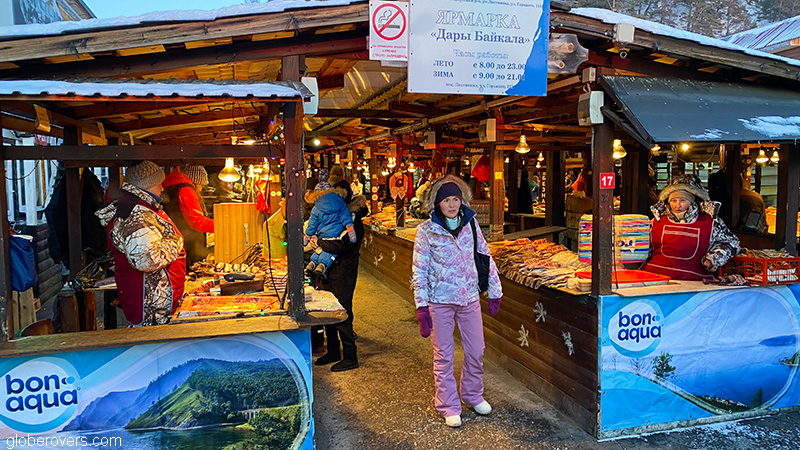
Listvyanka is a small town squeezed into a narrow strip of land between the north shore of Lake Baikal and the high hills. Russian pioneers came to this spot during the middle of the 17th century though it took about a hundred years before a settlement was established. This old-style Siberian village, situated at the source of the Angara River along the lake, is famous for its trade history.
Due to its location on the shores of the lake, and its proximity to Irkutsk, the town sees more visitors than all other towns and villages along Lake Baikal combined.
It gets particularly busy here during summer weekends when city dwellers from Irkutsk descend on the town to enjoy the crystal clear waters. The lake is picturesque and offers activities all year round which guarantees the town a constant flow of visitors.
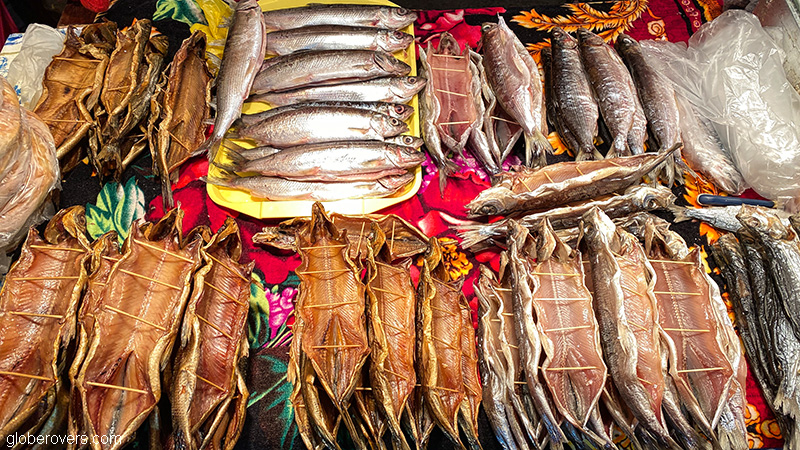

Listvyanka has a few places of interest such as Chersky Rock viewpoint, Baikal limnological museum, an arboretum (botanical collection of trees), a nerpinary (sealarium), and a cableway.
A retro park, owned by the Osipovs, near the Church of Saint Nicholas is decorated with wacky sculpture pieces fashioned from old Soviet-era cars and motorbikes.
While it is worth spending a day or two to check out the town and enjoy the food, Listvyanka more importantly serves as the starting point for excursions on the lake and entry point for the area’s hiking trails.

Excursions from Listvyanka
Listvyanka is a popular launching point from which to board boat tours in summer, and hydrofoil excursions in mid-winter when the lake is frozen.
In summer, a variety of boat tours are on offer, including some multi-day leisure cruises as well as live-aboard diving excursions. Fishing trips offer the opportunity to catch omul fish for the pan. Full-day boat tours, or even tours of just a couple of hours, are also available and stop at a few scenic locations along the shores of the lake.
Many types of excursions depart from Listvyanka to places across the lake
Lake Baikal is a completely different experience in winter! As the entire lake freezes over, it allows activities such as ice-skating, ice-fishing, snowmobiling, dog-sledding and even cross-country skiing.

One of the more relaxed ways to enjoy the best parts of the frozen lake is to hop inside a hovercraft that ever so smoothly sweeps across the frozen surface. Locally referred to as a khivous, the hovercraft is an amphibious air-cushioned vehicle propelled by a massive rear-mounted fan designed to literally sweep across the frozen surface at high speeds.
The hovercraft full-day excursions typically travel well over 200 kilometres (124 mi) northwest up along the lakeshore to reach the village of Dyuny in Peschanaya Bay. This spectacular bay, and several others along the shore, can only be reached by hovercraft in winter and boat in summer.

At the village of Dyuny, a hearty lunch can be enjoyed in a cozy wooden cabin. After lunch, a hike up the nearby hill, known as the Big Bell Tower, is recommended for panoramic views over the frozen lake. The ice formations in this area look spectacular from the high vantage point.
En route to Peschanaya Bay, the hovercraft may stop at scenic places such as Tolstiy Cape, Baklaniy Rock, Bolshoye Goloustnoye, and Bolshiye Koty. Most of these places can only be reached via the lake’s water or ice.
Bolshoye Goloustnoye is known as one of the best places to see the lake’s “frozen bubbles”. The lake floor here has a high concentration of methane vents that constantly emit gas bubbles rising to the surface. As the surface starts freezing in early winter, the bubbles slowly get trapped in the ice. This creates a very unusual sight.

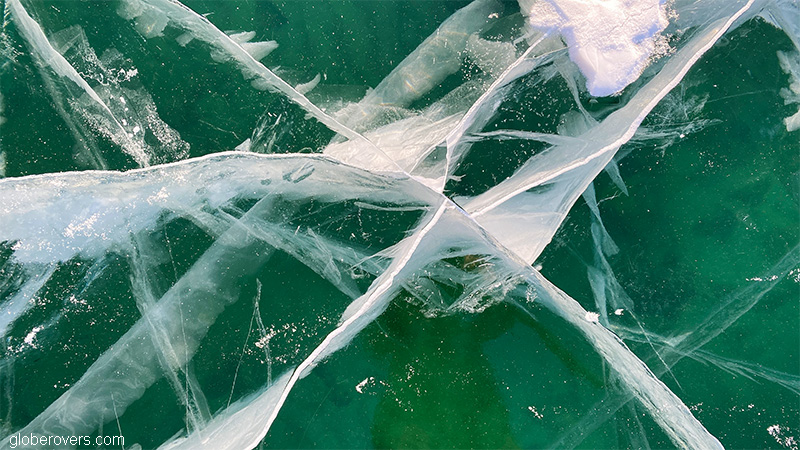
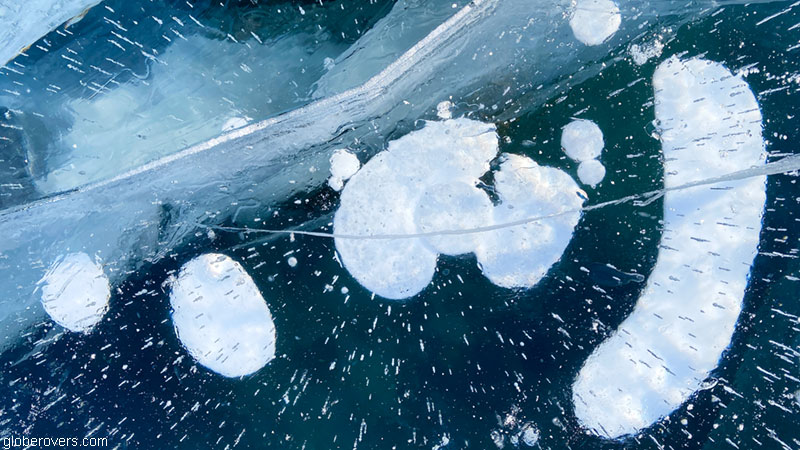

Frozen bubbles are also plentiful a short distance south at Bolshaya Kadilnaya as well as at Ukhan Cape on Olkhon Island.
While the ice near the shore has the most incredible and wacky formations, the hovercraft will sometimes travel a few kilometres away from the shore to where the ice is more smooth.
If there has been no snow accumulation, which is typical but not guaranteed, the ice surface in some areas is as shiny and smooth as glass.

Some hovercraft day-tours may head up to Olkhon Island, though at over 400 kilometres (248 mi) from Listvyanka, this will be a long and rushed day, which probably won’t allow much time to photograph and enjoy the ice.
My excursion to Listvyanka, including the adventurous hovercraft day-trip, was kindly sponsored by Baikal Terra, a tour operator based in Irkutsk.
This agency is known for their affordable tours to Olkhon Island, Listvyanka, Maloe More, Buryatia, Chivyrkuy Bay, and many other places around the region.
Lida, the owner, is from the Buryat ethnic group, and is an excellent guide.

☛ Read more: Blog posts of Russia
Essential Information
Getting There
Lake Baikal can be reached by either plane or train, or a long road trip. Planes fly into the town of Irkutsk from a few Russian cities, as well as from several international cities across Asia.
Irkutsk lies along the Trans-Siberian train route, so it is easy to stop over in Irkutsk before continuing the journey.
Getting Around
Public transport around the region is best by shared taxis and minivans. Book a day or two in advance and the minivan may even pick you up at your hotel.
For a more convenient way of travel, and to reach the more remote destinations, renting a vehicle with a driver/guide is highly recommended.
Photography
The Baikal Region is photogenic, particularly in the middle of winter. Bring along a good prime lens to capture the delicate ice crystals, as well as a wide-angle lens to photograph the ice caves and the interiors of the domed churches. A polarized filter will help eliminate glare on the ice.
When to Go
The area is an all-year-round destination. Summers are warm for hiking, camping, and even swimming in the lake. Spring and autumn offer beautiful seasonal colours.
Winter is magical as the lake freezes over and turns into a winter delight.
Where to Stay
While towns such as Irkutsk and Ulan-Ude (and even Khuzhir on Olkhon Island) have several hotels and guesthouses that can be booked online, the smaller villages are best booked via a local agency.
Olkhon Island: Stay at Nikita’s Homestead.
Safety
The safety risks in this region come mostly from the natural attractions, rather than people. The area is rugged and poses threats from animal attacks, as well as insects. Best to travel with a guide in the remote areas, particularly during the cold winter months.
Dining Out
The area is known for its excellent Russian and Siberian restaurants. For affordable dining in Irkutsk, visit Posnaya 38 restaurant north of the Angara Hotel and west of Kirov’s Park. Upscale dining is best at Rassol’nik Restaurant at the northern end of 130 Kvartal.
Train Travel
The Trans-Siberian train goes through Irkutsk so it is an alternative to arriving by plane or by ultra long-distance road travel.
Once in Irkutsk, train travel is limited to the Circum-Baikal Railway which runs for 89 km (55 mi) along the lake from near its southernmost point at Slyudyanka to Port Baikal at the mouth of the Angara River.
Cost of Travel
Getting here may be the biggest expense. The costs of local travel, food, and lodging are not outrageous. Tours are expensive if booked online prior to arrival. Best to shop around once you are in Irkutsk. Most destinations can be visited without a tour.
Book your travels around Lake Baikal with these excellent local operators: (Tell them GlobeRovers Magazine sent you!)
BAIKAL TERRA:
Contact Lida at terrabaikal@yandex.ru.
Website: baikalterra.com/en/
BAIKALER:
Contact Jack Sheremetoff at baikaler@gmail.com
Website: baikaler.com
BAIKAL TOUR:
Contact Denis Sobnakov at sobnakov@gmail.com
Website: baikaltour.net
ACCOMMODATION ON OLKHON ISLAND:
Nikita’s Homestead
olkhon.info/en/manor-house/


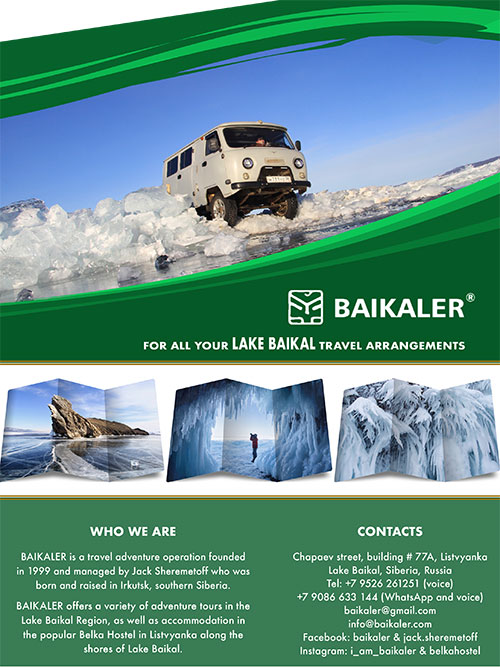

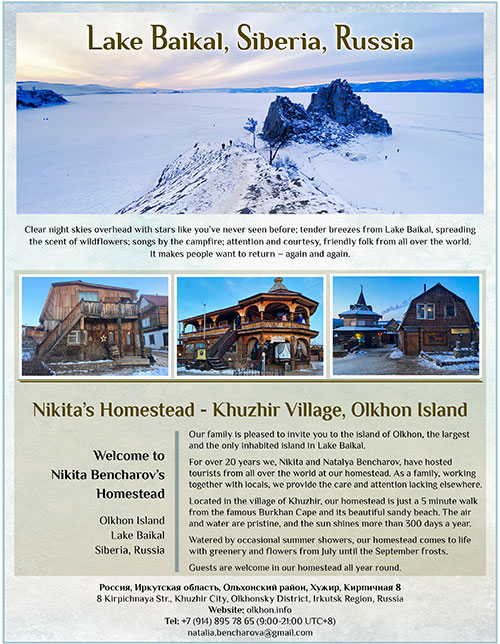

Blog post and photos by Peter who has been travelling almost full-time since 2005 and has been to over 122 countries. He visited several countries, such as Japan, more than 20 times. Peter is Editor-in-Chief and Publisher of GlobeRovers Magazine, an independent travel magazine focused on intrepid destinations.
